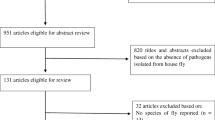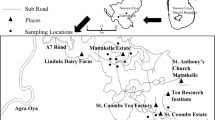Abstract
The Cephalopina titillator is one of the most important causative agents of nasal myiasis in camels. This study aimed to explore the prevalence, histopathological effects, and molecular identification of C. titillator infestation in camels of Kerman province, South-Eastern Iran, between 2019 and 2021. The larvae were placed in 10% formalin for histopathological evaluation and species identification. Pieces of larval abdominal segments of C. titillator were selected for extraction of DNA. Partial mitochondrial CO1 genes were sequenced for final analysis. Out of the 870 camels examined, 339 (38.9%) were infested with larval stages of C. titillator. There was a significant difference between age and infection rate (P = 0.001), while no association between males and females (P = 0.074) was found. The infection rate was significantly higher in the winter (P < 0.001) than in the other seasons. In this study, different lesions depending on duration, locations, and the depth of larval adhesion notably degeneration changes, necrosis, and ulceration were observed. Also, in chronic cases, granulation tissue reactions were organized. Cephalopina titillator was confirmed by PCR sequencing analysis using mitochondrial CO1 region. A 582 bp nucleotide sequence was deposited in GenBank under the MW136151 accession number. Phylogenetic analysis of CO1 produced a single uniform sister clade to MZ209004 and MW167083 records from China and Iraq, respectively. The high prevalence of C. titillator in camels in this region and other areas of Iran declares that the country is in an endemic status and displays the existence of the potential risk for camels.



Similar content being viewed by others
References
Abd El-Rahman S (2010) Prevalence and pathology of nasal myiasis in camels slaughtered in El-Zawia Province-Western Libya: with a reference to thyroid alteration and renal lipidosis. Glob Vet 4:190–197
Abu El Ezz NMT, Hassan NMF, El Namaky AH, Abo-Aziza F (2018) Efficacy of some essential oils on Cephalopina titillator with special concern to nasal myiasis prevalence among camels and its consequent histopathological changes. J Parasit Dis 42:196–203. https://doi.org/10.1007/s12639-018-0982-2
Al-Rawashdeh OF, Al-Ani FK, Sharrif LA et al (2000) A survey of camel (Camelus dromedarius) diseases in Jordan. J Zoo Wildl Med 31:335–338
Angulo-Valadez C, Scholl P, Cepeda-Palacios R et al (2010) Nasal bots a fascinating world! Vet Parasitol 174:19–25
Attia MM, Mahdy OA (2022) Fine structure of different stages of camel nasal bot; Cephalopina titillator (Diptera: Oestridae). Int J Trop Insect Sci 42:677–684
El Bassiony GM, Al Sagair OA, El Daly ES, El Nady AM (2005) Alterations in the pituitary-thyroid axis in camel Camelus dromedarius infected by larvae of nasal bot fly Cephalopina titillator. J Anim Vet Adv 4:345–348
Basu AK, Charles RA (2019) Larvae of Cephalopina titillator (Clark 1816) (Diptera: Oestridae) causing nasopharyngeal myiasis of camels: an overview. CAB Rev Perspect Agric Vet Sci Nutr Nat Resour 14:1–9. https://doi.org/10.1079/PAVSNNR201914048
Burgemeister R, Leyk W, Goessler R (1975) Investigations on the occurrence of parasites and of bacterial and virus infections in Southern Tunisian dromedaries. Dtsch Tierarztl Wschr 82:341–348
Cameron SL, Lambkin CL, Barker SC, Whiting MF (2007) A mitochondrial genome phylogeny of Diptera: whole genome sequence data accurately resolve relationships over broad timescales with high precision. Syst Entomol 32:40–59
Cepeda-Palacios R, Scholl PJ (2000) Intra-puparial development in <I>Oestrus ovis</I> (Diptera: Oestridae). J Med Entomol 37:239–245. https://doi.org/10.1603/0022-2585-37.2.239
Folmer O, Black M, Hoeh W et al (1994) DNA primers for amplification of mitochondrial cytochrome c oxidase subunit I from diverse metazoan invertebrates. Mol Mar Biol Biotechnol 3:294–299
Guitton C, Perez JM, Dorchies P (2001) Scanning electron microscopy of larval instars and imago of Oestrus caucasicus (Grunin 1948) (Diptera: Oestridae). Parasite 8:155–160. https://doi.org/10.1051/parasite/2001082155
Hafedh AA, Humide AO, Alrikaby NJA (2021) Cytochrome oxidase subunit I (COI) gene sequencing for identification of Cephalopina titillator local isolates from camels in Thi-Qar Province/Iraq. Ann Rom Soc Cell Biol 25:3146–3152
Hussein MF, Hassan HAR, Bilal HK et al (1983) Cephalopina titillator (Clark 1797) infection in Saudi Arabian camels. Zentralblatt Für Veterinärmedizin R B 30:553–558
Jalali MHR, Dehghan S, Haji A, Ebrahimi M (2016) Myiasis caused by Cephalopina titillator (Diptera: Oestridae) in camels (Camelus dromedarius) of semi-arid areas in Iran: distribution and associated risk factors. Comp Clin Path 25:677–680. https://doi.org/10.1007/s00580-016-2246-9
Kimura M (1980) A simple method for estimating evolutionary rates of base substitutions through comparative studies of nucleotide sequences. J Mol Evol 16:111–120
Li X, Yan L, Pape T et al (2020) Evolutionary insights into bot flies (Insecta: Diptera: Oestridae) from comparative analysis of the mitochondrial genomes. Int J Biol Macromol 149:371–380
Morsy TA, Aziz AS, Mazyad SA, Al Sharif K (1998) Myiasis caused by Cephalopina titillator (Clark) in slaughtered camels in Al Arish Abattoir, North Sinai governorate. Egypt J Egypt Soc Parasitol 28:67–73
Musa MT, Harrison M (1989) Observations on Sudanese camel nasal myiasis caused by the larvae of Cephalopina titillator. Rev Elev Med Vet Pays Trop 42(1):27–31
Oryan A, Valinezhad A, Moraveji M (2008) Prevalence and pathology of camel nasal myiasis in eastern areas of Iran. Trop Biomed 25:30–36
Sazmand A, Joachim A (2017) Parasitic diseases of camels in Iran (1931–2017): a literature review. Parasite 24:21
Schwartz HJ, Dioli M (1992) One-humped camel (Camelus dromedarius) in eastern Africa. J. Margraf, The University of Michigan
Shakerian A, Hossein SR, Abbasi M (2011) Prevalence of Cephalopina titillator (Diptera: Oestridae) larvae in one-humped camel (Camelus dromedarius) in Najaf-Abad. Iran Glob Vet 6:320–323
Yao H, Liu M, Ma W et al (2022) Prevalence and pathology of Cephalopina titillator infestation in Camelus bactrianus from Xinjiang, China. BMC Vet Res 18:1–15
Zumpt F (1965) Myiasis in man and animals in the old world. A Text B Physicians Vet Zool London Butterworth Co Ltd 109
Acknowledgements
This study was funded by Shahid Bahonar University of Kerman, Kerman, Iran (Grant Number 1400.1.1.408, Reza Kheirandish). The authors appreciate the cooperation of Kerman Industrial Slaughterhouse personnel.
Author information
Authors and Affiliations
Contributions
ES collected samples, analyzed and interpreted the data, and drafted the manuscript, MHR designed, reviewed, and edited the manuscript, SRN supervised the field and laboratory experiment, MB analyzed, reviewed, and edited the manuscript, SN conducted molecular experiments, SF collected samples, MHP and RK conceived, designed and Supervision the study and reviewed the manuscript.
Corresponding authors
Ethics declarations
Conflict of interest
The authors declare no conflicts of interest for the work presented here.
Ethical approval
The authors confirm that the ethical policies of the journal, as noted on the journal’s author guidelines page, have been adhered to. Ethical approval for this study was granted by the Research Ethics Committees of the Veterinary Faculty of the Shahid Bahonar University of Kerman (Approval ID: IR.UK.VETMED.REC.1401.013).
Consent for publication
Not applicable.
Additional information
Publisher's Note
Springer Nature remains neutral with regard to jurisdictional claims in published maps and institutional affiliations.
Rights and permissions
Springer Nature or its licensor (e.g. a society or other partner) holds exclusive rights to this article under a publishing agreement with the author(s) or other rightsholder(s); author self-archiving of the accepted manuscript version of this article is solely governed by the terms of such publishing agreement and applicable law.
About this article
Cite this article
Shamsi, E., Radfar, M.H., Nourollahifard, S.R. et al. Nasopharyngeal myiasis due to Cephalopina titillator in Southeastern Iran: a prevalence, histopathological, and molecular assessment. J Parasit Dis 47, 369–375 (2023). https://doi.org/10.1007/s12639-023-01580-z
Received:
Accepted:
Published:
Issue Date:
DOI: https://doi.org/10.1007/s12639-023-01580-z




